
Laura Álvaro-Llorente
@lauralvllo.bsky.social
PhD student at Evodynamics lab (Hospital Ramón y Cajal). New strategies against antibiotic resistant bacteria and AMR evolution in bacteria.
Reposted by Laura Álvaro-Llorente
Dissecting the fitness effects of a carbapenem resistance plasmid in clinical Enterobacterales using plasmid-wide CRISPRi screens
@aliciapcv.bsky.social @jorgesastred.bsky.social @sanmillan.bsky.social @cnb-csic.bsky.social
#bacteria #plasmids
@aliciapcv.bsky.social @jorgesastred.bsky.social @sanmillan.bsky.social @cnb-csic.bsky.social
#bacteria #plasmids

Dissecting pOXA-48 fitness effects in clinical Enterobacterales using plasmid-wide CRISPRi screens - Nature Communications
This study investigates the effects of the carbapenem resistance plasmid pOXA-48 in clinical enterobacteria. Using CRISPRi screens, the authors revealed that the carbapenemase OXA-48 has a role in the plasmid-associated fitness costs.
bit.ly
October 17, 2025 at 4:56 PM
Dissecting the fitness effects of a carbapenem resistance plasmid in clinical Enterobacterales using plasmid-wide CRISPRi screens
@aliciapcv.bsky.social @jorgesastred.bsky.social @sanmillan.bsky.social @cnb-csic.bsky.social
#bacteria #plasmids
@aliciapcv.bsky.social @jorgesastred.bsky.social @sanmillan.bsky.social @cnb-csic.bsky.social
#bacteria #plasmids
Reposted by Laura Álvaro-Llorente
Delighted to see our paper studying the evolution of plasmids over the last 100 years, now out! Years of work by Adrian Cazares, also Nick Thomson @sangerinstitute.bsky.social - this version much improved over the preprint. Final version should be open access, apols.
Thread 1/n
Thread 1/n

September 25, 2025 at 9:29 PM
Delighted to see our paper studying the evolution of plasmids over the last 100 years, now out! Years of work by Adrian Cazares, also Nick Thomson @sangerinstitute.bsky.social - this version much improved over the preprint. Final version should be open access, apols.
Thread 1/n
Thread 1/n
Reposted by Laura Álvaro-Llorente
New preprint from the group: @lucydillon.bsky.social analysis of 16,000+ genomes finds Bacteria cannot combine certain resistance genes as they are mutually exclusive, forcing them down incompatible evolutionary paths.
biorxiv.org/content/10.1101/2025.08.20.671315v1
@jomcinerney.bsky.social
biorxiv.org/content/10.1101/2025.08.20.671315v1
@jomcinerney.bsky.social

Genomic constraints shape the evolution of alternative routes to drug resistance in prokaryotes.
Background: Variation within the prokaryotic pangenome is not random, and natural selection that favours particular combinations of genes appears to dominate over random drift. What is less clear is w...
biorxiv.org
August 22, 2025 at 10:38 AM
New preprint from the group: @lucydillon.bsky.social analysis of 16,000+ genomes finds Bacteria cannot combine certain resistance genes as they are mutually exclusive, forcing them down incompatible evolutionary paths.
biorxiv.org/content/10.1101/2025.08.20.671315v1
@jomcinerney.bsky.social
biorxiv.org/content/10.1101/2025.08.20.671315v1
@jomcinerney.bsky.social
Reposted by Laura Álvaro-Llorente
New paper alert! 🚨
Plasmids promote bacterial evolution through a copy number-driven increase in mutation rate.
We combine theory, simulations, experimental evolution, and bioinformatics to demonstrate that mutation rates scale with plasmid copy number.
Let's dive in! 🧵👇
Plasmids promote bacterial evolution through a copy number-driven increase in mutation rate.
We combine theory, simulations, experimental evolution, and bioinformatics to demonstrate that mutation rates scale with plasmid copy number.
Let's dive in! 🧵👇

Plasmids promote bacterial evolution through a copy number-driven increase in mutation rate
Plasmids are autonomously replicating DNA molecules that stably coexist with chromosomes in bacterial cells. These genetic elements drive horizontal gene transfer and play a fundamental role in bacter...
www.biorxiv.org
July 22, 2025 at 9:38 AM
New paper alert! 🚨
Plasmids promote bacterial evolution through a copy number-driven increase in mutation rate.
We combine theory, simulations, experimental evolution, and bioinformatics to demonstrate that mutation rates scale with plasmid copy number.
Let's dive in! 🧵👇
Plasmids promote bacterial evolution through a copy number-driven increase in mutation rate.
We combine theory, simulations, experimental evolution, and bioinformatics to demonstrate that mutation rates scale with plasmid copy number.
Let's dive in! 🧵👇
Reposted by Laura Álvaro-Llorente
Our paper “Genetic determinants of pOXA-48 plasmid maintenance and propagation in Escherichia coli” is now online in @natcomms.nature.com ✨
👉 www.nature.com/articles/s41...
@cnrs-rhoneauvergne.bsky.social @mmsb-lyon.bsky.social
👉 www.nature.com/articles/s41...
@cnrs-rhoneauvergne.bsky.social @mmsb-lyon.bsky.social

Genetic determinants of pOXA-48 plasmid maintenance and propagation in Escherichia coli - Nature Communications
pOXA-48 plasmids have emerged as key vectors of carbapenem resistance within Enterobacteriaceae. In this study, the authors use a transposon sequencing (Tn-seq) approach to identify genetic determinan...
www.nature.com
August 20, 2025 at 3:19 PM
Our paper “Genetic determinants of pOXA-48 plasmid maintenance and propagation in Escherichia coli” is now online in @natcomms.nature.com ✨
👉 www.nature.com/articles/s41...
@cnrs-rhoneauvergne.bsky.social @mmsb-lyon.bsky.social
👉 www.nature.com/articles/s41...
@cnrs-rhoneauvergne.bsky.social @mmsb-lyon.bsky.social
Reposted by Laura Álvaro-Llorente
First of all, we recommend reading a complementary study led by Yannick Baffert and @sbigot.bsky.social, in which they use Tn-seq to study the genetic determinants of pOXA-48 in plasmid maintenance and conjugation. Really cool piece of work that reaches similar conclusions to ours!
2/14
2/14

Genetic determinants of pOXA-48 plasmid maintenance and propagation in Escherichia coli - Nature Communications
pOXA-48 plasmids have emerged as key vectors of carbapenem resistance within Enterobacteriaceae. In this study, the authors use a transposon sequencing (Tn-seq) approach to identify genetic determinan...
www.nature.com
August 20, 2025 at 1:25 PM
First of all, we recommend reading a complementary study led by Yannick Baffert and @sbigot.bsky.social, in which they use Tn-seq to study the genetic determinants of pOXA-48 in plasmid maintenance and conjugation. Really cool piece of work that reaches similar conclusions to ours!
2/14
2/14
Reposted by Laura Álvaro-Llorente
This work is finally published! 🥳🧬
Plasmids are associated with very variable fitness costs in their different bacterial hosts. But, what is the contribution of each of the plasmid-genes in these host-specific effects? Study led by
@jorgesastred.bsky.social, @sanmillan.bsky.social and myself! 1/14
Plasmids are associated with very variable fitness costs in their different bacterial hosts. But, what is the contribution of each of the plasmid-genes in these host-specific effects? Study led by
@jorgesastred.bsky.social, @sanmillan.bsky.social and myself! 1/14
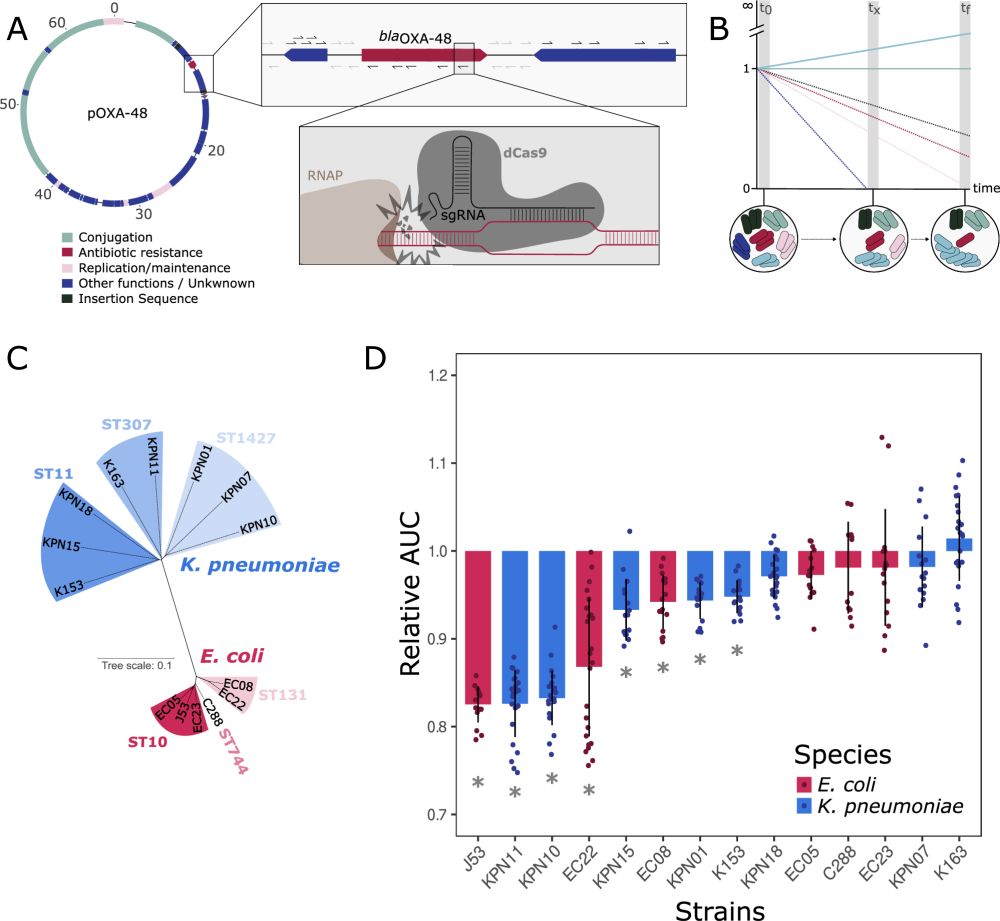
Dissecting pOXA-48 fitness effects in clinical Enterobacterales using plasmid-wide CRISPRi screens
Nature Communications - This study investigates the effects of the carbapenem resistance plasmid pOXA-48 in clinical enterobacteria. Using CRISPRi screens, the authors revealed that the...
rdcu.be
August 20, 2025 at 1:25 PM
This work is finally published! 🥳🧬
Plasmids are associated with very variable fitness costs in their different bacterial hosts. But, what is the contribution of each of the plasmid-genes in these host-specific effects? Study led by
@jorgesastred.bsky.social, @sanmillan.bsky.social and myself! 1/14
Plasmids are associated with very variable fitness costs in their different bacterial hosts. But, what is the contribution of each of the plasmid-genes in these host-specific effects? Study led by
@jorgesastred.bsky.social, @sanmillan.bsky.social and myself! 1/14
Reposted by Laura Álvaro-Llorente
Thrilled to see our Kiwa story out today! A membrane-associated supercomplex that senses infection and blocks replication and transcription.
www.cell.com/cell/fulltex...
Huge congratulations to Yi and Zhiying for bringing it home, to Thomas for starting us off, and to all the collaborators.
www.cell.com/cell/fulltex...
Huge congratulations to Yi and Zhiying for bringing it home, to Thomas for starting us off, and to all the collaborators.

Kiwa is a membrane-embedded defense supercomplex activated at phage attachment sites
Zhang, Todeschini, and Wu et al. show that the bacterial defense system Kiwa senses
phage attachment at the membrane and assembles a transmembrane complex that halts
infection by blocking phage DNA re...
www.cell.com
July 28, 2025 at 7:43 PM
Thrilled to see our Kiwa story out today! A membrane-associated supercomplex that senses infection and blocks replication and transcription.
www.cell.com/cell/fulltex...
Huge congratulations to Yi and Zhiying for bringing it home, to Thomas for starting us off, and to all the collaborators.
www.cell.com/cell/fulltex...
Huge congratulations to Yi and Zhiying for bringing it home, to Thomas for starting us off, and to all the collaborators.
Reposted by Laura Álvaro-Llorente
#phage #phagesky
Phage-based delivery of CRISPR-associated transposases for targeted bacterial editing | PNAS www.pnas.org/doi/10.1073/...
Phage-based delivery of CRISPR-associated transposases for targeted bacterial editing | PNAS www.pnas.org/doi/10.1073/...
PNAS
Proceedings of the National Academy of Sciences (PNAS), a peer reviewed journal of the National Academy of Sciences (NAS) - an authoritative source of high-impact, original research that broadly spans...
www.pnas.org
July 29, 2025 at 4:47 AM
#phage #phagesky
Phage-based delivery of CRISPR-associated transposases for targeted bacterial editing | PNAS www.pnas.org/doi/10.1073/...
Phage-based delivery of CRISPR-associated transposases for targeted bacterial editing | PNAS www.pnas.org/doi/10.1073/...
Reposted by Laura Álvaro-Llorente
Reposted by Laura Álvaro-Llorente
ICYMI: New online! Experimental evolution in an era of molecular manipulation

Experimental evolution in an era of molecular manipulation
Nature Reviews Genetics, Published online: 21 July 2025; doi:10.1038/s41576-025-00867-6In this Review, Ascensao and Desai discuss how methodological advances in genotype and phenotype manipulation are transforming experimental evolution approaches and providing new insights into the underlying genetics and forces that shape phenotypic evolution.
www.nature.com
July 28, 2025 at 2:46 PM
ICYMI: New online! Experimental evolution in an era of molecular manipulation
Reposted by Laura Álvaro-Llorente
Excited 🥳 to share our latest work on gut phages!
Big thanks to @epcrocha.bsky.social, Erick D, Camille d'H, @fplazaonate.bsky.social, Quentin LB, and all others involved for support and contributions! 🙌
Out in Cell Reports @cp-cellreports.bsky.social
doi.org/10.1016/j.ce...
Here's what we found 🤓
Big thanks to @epcrocha.bsky.social, Erick D, Camille d'H, @fplazaonate.bsky.social, Quentin LB, and all others involved for support and contributions! 🙌
Out in Cell Reports @cp-cellreports.bsky.social
doi.org/10.1016/j.ce...
Here's what we found 🤓
July 28, 2025 at 8:41 AM
Excited 🥳 to share our latest work on gut phages!
Big thanks to @epcrocha.bsky.social, Erick D, Camille d'H, @fplazaonate.bsky.social, Quentin LB, and all others involved for support and contributions! 🙌
Out in Cell Reports @cp-cellreports.bsky.social
doi.org/10.1016/j.ce...
Here's what we found 🤓
Big thanks to @epcrocha.bsky.social, Erick D, Camille d'H, @fplazaonate.bsky.social, Quentin LB, and all others involved for support and contributions! 🙌
Out in Cell Reports @cp-cellreports.bsky.social
doi.org/10.1016/j.ce...
Here's what we found 🤓
Reposted by Laura Álvaro-Llorente
tRNA modification profiling reveals epitranscriptome regulatory networks in Pseudomonas aeruginosa 🦠👏High-throughput tRNA epitranscriptome profiling using mass spec on P. aeruginosa transposon insertion library and links with metabolic networks #microsky #rnasky doi.org/10.1093/nar/...
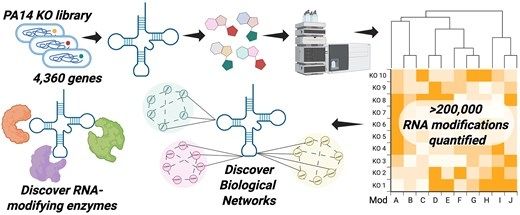
tRNA modification profiling reveals epitranscriptome regulatory networks in Pseudomonas aeruginosa
Abstract. Transfer RNA (tRNA) modifications have emerged as critical post-transcriptional regulators of gene expression affecting diverse biological and di
doi.org
July 28, 2025 at 8:28 PM
tRNA modification profiling reveals epitranscriptome regulatory networks in Pseudomonas aeruginosa 🦠👏High-throughput tRNA epitranscriptome profiling using mass spec on P. aeruginosa transposon insertion library and links with metabolic networks #microsky #rnasky doi.org/10.1093/nar/...
Reposted by Laura Álvaro-Llorente
Here's our new broad review on the extended mobility of plasmids, about all mechanisms driving and limiting their transfer. From conjugation to conduction, phage-plasmids to hitchers, molecular to evolutionary dynamics, ecology to biotech. The state of affairs. 1/9 academic.oup.com/nar/article/...
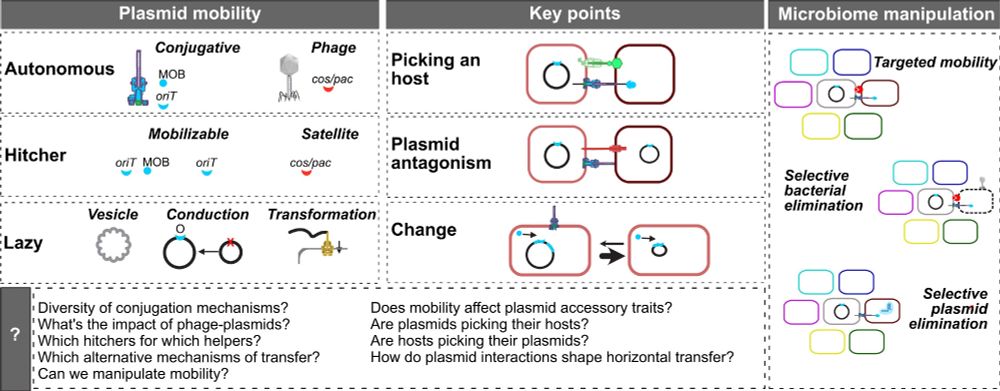
July 23, 2025 at 7:35 AM
Here's our new broad review on the extended mobility of plasmids, about all mechanisms driving and limiting their transfer. From conjugation to conduction, phage-plasmids to hitchers, molecular to evolutionary dynamics, ecology to biotech. The state of affairs. 1/9 academic.oup.com/nar/article/...
Had an amazing time at #FEMS2025 last week, where I presented our latest findings on collateral sensitivity mediated by beta-lactamases ☯️ Big thanks to everyone who came by! So proud of my colleagues for their brilliant talks and posters ✨
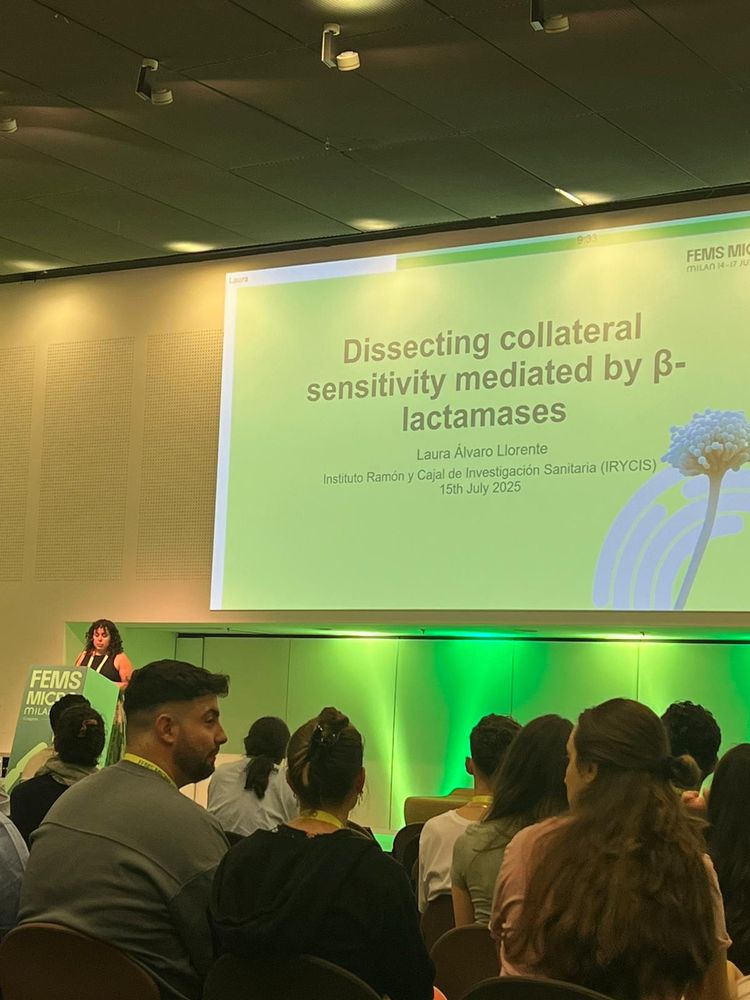

July 23, 2025 at 6:43 AM
Had an amazing time at #FEMS2025 last week, where I presented our latest findings on collateral sensitivity mediated by beta-lactamases ☯️ Big thanks to everyone who came by! So proud of my colleagues for their brilliant talks and posters ✨
The perfect summer read is here! 👇🏽
New paper alert! 🚨
Plasmids promote bacterial evolution through a copy number-driven increase in mutation rate.
We combine theory, simulations, experimental evolution, and bioinformatics to demonstrate that mutation rates scale with plasmid copy number.
Let's dive in! 🧵👇
Plasmids promote bacterial evolution through a copy number-driven increase in mutation rate.
We combine theory, simulations, experimental evolution, and bioinformatics to demonstrate that mutation rates scale with plasmid copy number.
Let's dive in! 🧵👇

Plasmids promote bacterial evolution through a copy number-driven increase in mutation rate
Plasmids are autonomously replicating DNA molecules that stably coexist with chromosomes in bacterial cells. These genetic elements drive horizontal gene transfer and play a fundamental role in bacter...
www.biorxiv.org
July 23, 2025 at 6:17 AM
The perfect summer read is here! 👇🏽
A must read paper! 👇
Curious about plasmid biology? Our latest paper is out now in Nature Communications! 🚨
doi.org/10.1038/s414...
We analyzed thousands of diverse bacterial plasmids to shed light for the first time on a key aspect of plasmid biology: plasmid copy number. 1/7 👇
doi.org/10.1038/s414...
We analyzed thousands of diverse bacterial plasmids to shed light for the first time on a key aspect of plasmid biology: plasmid copy number. 1/7 👇
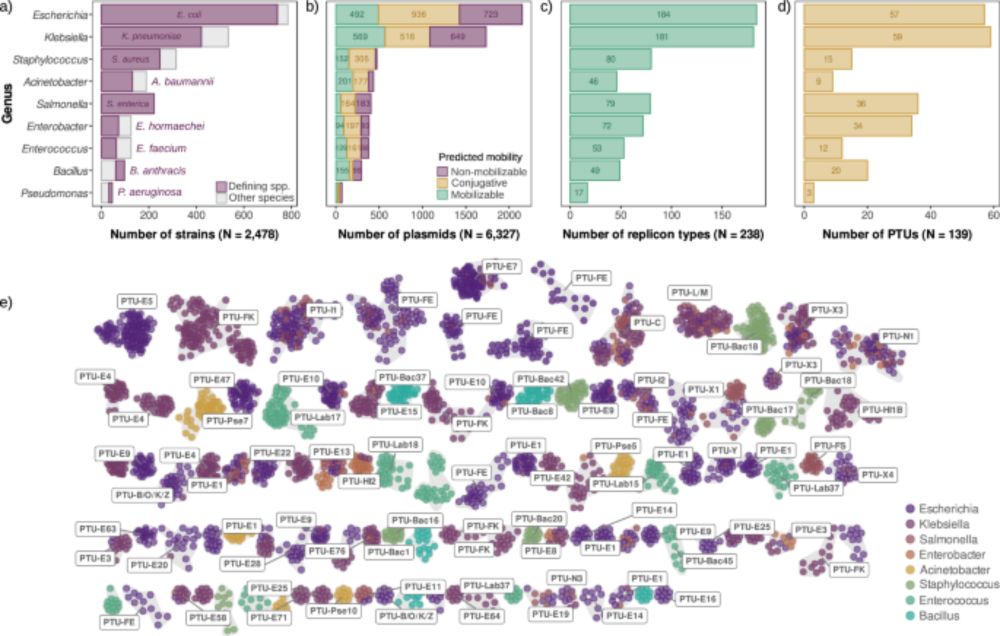
Universal rules govern plasmid copy number - Nature Communications
Plasmids exhibit a broad range of sizes and copies per cell, and these two parameters appear to be negatively correlated. Here, Ramiro-Martínez et al. analyse the copy number of thousands of diverse b...
doi.org
July 2, 2025 at 12:18 PM
A must read paper! 👇
Reposted by Laura Álvaro-Llorente
🚨🚨New paper out in @natcomms.nature.com!!
Come for the first large-scale analysis of plasmid copy number across species,
stay for one of the most intriguing results of my lab: universal scaling laws in plasmid biology! 📈🧬
👉 www.nature.com/articles/s41...
Come for the first large-scale analysis of plasmid copy number across species,
stay for one of the most intriguing results of my lab: universal scaling laws in plasmid biology! 📈🧬
👉 www.nature.com/articles/s41...
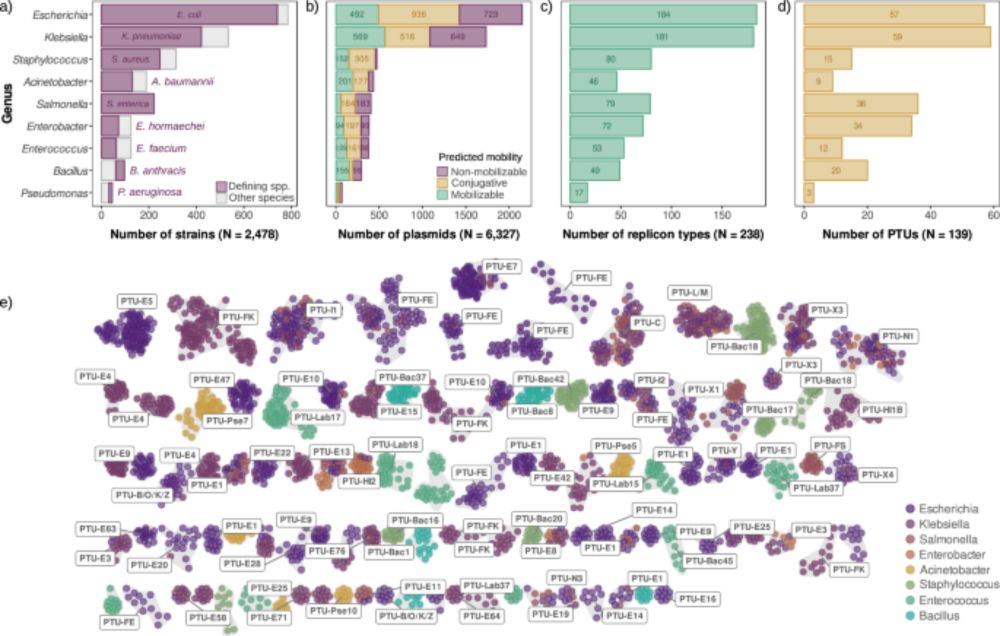
Universal rules govern plasmid copy number - Nature Communications
Plasmids exhibit a broad range of sizes and copies per cell, and these two parameters appear to be negatively correlated. Here, Ramiro-Martínez et al. analyse the copy number of thousands of diverse b...
www.nature.com
July 2, 2025 at 11:08 AM
🚨🚨New paper out in @natcomms.nature.com!!
Come for the first large-scale analysis of plasmid copy number across species,
stay for one of the most intriguing results of my lab: universal scaling laws in plasmid biology! 📈🧬
👉 www.nature.com/articles/s41...
Come for the first large-scale analysis of plasmid copy number across species,
stay for one of the most intriguing results of my lab: universal scaling laws in plasmid biology! 📈🧬
👉 www.nature.com/articles/s41...
Reposted by Laura Álvaro-Llorente
Scaling laws of bacterial and archaeal plasmids www.nature.com/articles/s41...

Scaling laws of bacterial and archaeal plasmids - Nature Communications
The capacity of a plasmid to express genes is constrained by parameters such as its length and copy number. Here, Maddamsetti et al. present a computational method that enables rapid and accurate dete...
www.nature.com
July 2, 2025 at 11:35 AM
Scaling laws of bacterial and archaeal plasmids www.nature.com/articles/s41...
Reposted by Laura Álvaro-Llorente
Universal rules govern plasmid copy number www.nature.com/articles/s41...
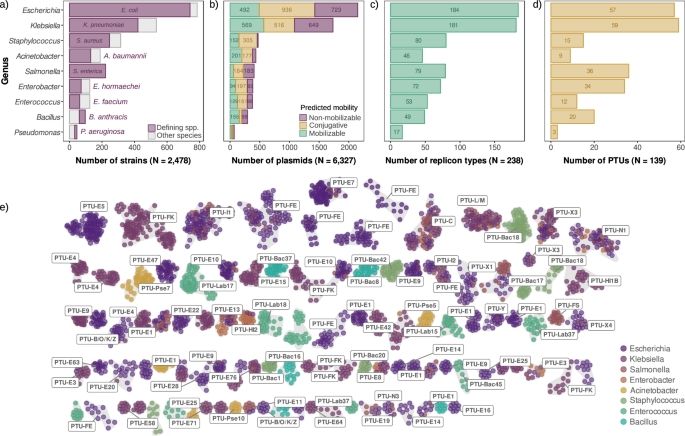
Universal rules govern plasmid copy number - Nature Communications
Plasmids exhibit a broad range of sizes and copies per cell, and these two parameters appear to be negatively correlated. Here, Ramiro-Martínez et al. analyse the copy number of thousands of diverse b...
www.nature.com
July 2, 2025 at 11:37 AM
Universal rules govern plasmid copy number www.nature.com/articles/s41...
Reposted by Laura Álvaro-Llorente
#NatMicroPicks
E. coli making paracetamol from plastic waste! 🦠💊
A new biocompatible chemistry for plastic waste upcycling using microbes.
#MicroSky #SynBio 🔧🧬
www.nature.com/articles/s41...
E. coli making paracetamol from plastic waste! 🦠💊
A new biocompatible chemistry for plastic waste upcycling using microbes.
#MicroSky #SynBio 🔧🧬
www.nature.com/articles/s41...

New-to-nature biocompatible chemistry for plastic waste upcycling - Nature Chemistry
Synthetic and biological chemistry are traditionally seen as separate fields. Now, a biocompatible chemical reaction enables an engineered microbe to convert plastic waste into valuable compounds unde...
www.nature.com
June 26, 2025 at 3:37 PM
#NatMicroPicks
E. coli making paracetamol from plastic waste! 🦠💊
A new biocompatible chemistry for plastic waste upcycling using microbes.
#MicroSky #SynBio 🔧🧬
www.nature.com/articles/s41...
E. coli making paracetamol from plastic waste! 🦠💊
A new biocompatible chemistry for plastic waste upcycling using microbes.
#MicroSky #SynBio 🔧🧬
www.nature.com/articles/s41...
Reposted by Laura Álvaro-Llorente
What determines who a phage can infect?
We tackled this question for temperate phages of Klebsiella — a bacterial pathogen — using a genome-wide association study (GWAS) and a massive protein testing effort.
👇 A thread!
We tackled this question for temperate phages of Klebsiella — a bacterial pathogen — using a genome-wide association study (GWAS) and a massive protein testing effort.
👇 A thread!

June 26, 2025 at 7:13 AM
What determines who a phage can infect?
We tackled this question for temperate phages of Klebsiella — a bacterial pathogen — using a genome-wide association study (GWAS) and a massive protein testing effort.
👇 A thread!
We tackled this question for temperate phages of Klebsiella — a bacterial pathogen — using a genome-wide association study (GWAS) and a massive protein testing effort.
👇 A thread!
Reposted by Laura Álvaro-Llorente
New mini-review on the respiratory microbiome and its contribution to human health from biotechnology 🫁🦠
@tmcoque.bsky.social @microbiotech.bsky.social
enviromicro-journals.onlinelibrary.wiley.com/doi/10.1111/...
@tmcoque.bsky.social @microbiotech.bsky.social
enviromicro-journals.onlinelibrary.wiley.com/doi/10.1111/...

The Respiratory Tract Microbiome and Human Health
The respiratory tract microbiome (RTM) trains the immune system and protects against infections. Changes in the RTM are linked to various respiratory diseases. High-throughput methodologies and compu...
enviromicro-journals.onlinelibrary.wiley.com
April 29, 2025 at 3:33 PM
New mini-review on the respiratory microbiome and its contribution to human health from biotechnology 🫁🦠
@tmcoque.bsky.social @microbiotech.bsky.social
enviromicro-journals.onlinelibrary.wiley.com/doi/10.1111/...
@tmcoque.bsky.social @microbiotech.bsky.social
enviromicro-journals.onlinelibrary.wiley.com/doi/10.1111/...
Reposted by Laura Álvaro-Llorente
New antibiotic class discovered by researchers at @mcmasteruniversity.bsky.social & @illinoispress.bsky.social
"A broad-spectrum lasso peptide antibiotic targeting the bacterial ribosome"
in @nature.com
Hope it can make it to market to help combat #AMR infections
www.nature.com/articles/s41...
"A broad-spectrum lasso peptide antibiotic targeting the bacterial ribosome"
in @nature.com
Hope it can make it to market to help combat #AMR infections
www.nature.com/articles/s41...

A broad-spectrum lasso peptide antibiotic targeting the bacterial ribosome - Nature
A new lasso peptide antibiotic exhibits broad-spectrum activity against Gram-negative and Gram-positive bacteria by interfering with bacterial protein synthesis, is unaffected by common resistanc...
www.nature.com
March 28, 2025 at 10:27 AM
New antibiotic class discovered by researchers at @mcmasteruniversity.bsky.social & @illinoispress.bsky.social
"A broad-spectrum lasso peptide antibiotic targeting the bacterial ribosome"
in @nature.com
Hope it can make it to market to help combat #AMR infections
www.nature.com/articles/s41...
"A broad-spectrum lasso peptide antibiotic targeting the bacterial ribosome"
in @nature.com
Hope it can make it to market to help combat #AMR infections
www.nature.com/articles/s41...
Reposted by Laura Álvaro-Llorente
The Eligo team did it again! We just shared on biorxiv the work we did towards the development of a CRISPR-Cas therapy targeting Shiga Toxin producing E. coli (STEC). www.biorxiv.org/content/10.1...
www.biorxiv.org
March 4, 2025 at 12:31 PM
The Eligo team did it again! We just shared on biorxiv the work we did towards the development of a CRISPR-Cas therapy targeting Shiga Toxin producing E. coli (STEC). www.biorxiv.org/content/10.1...


